Students gather outside I Cappuccini Guest House (as we did every morning we were in Rome) to take the Metro to the Vatican Museum. First we count off (Vos numerate: “number yourselves!”). The six adults count off too, shouting out their assigned Latin present active verb endings (-o! -s! -t! -mus! -tis! -nt!). Every one of us was unfailingly attentive to the modest dress code required for churches–Williston’s Purpose, Passion, and Integrity were in full bloom!
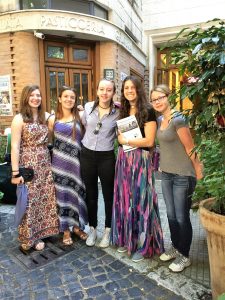
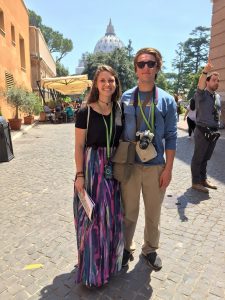
Walking to the Vatican Museum’s Pine Cone Courtyard, St. Peter’s Dome in the background:
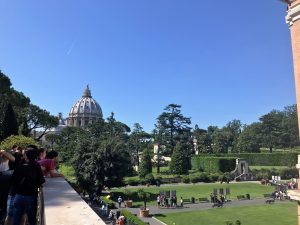
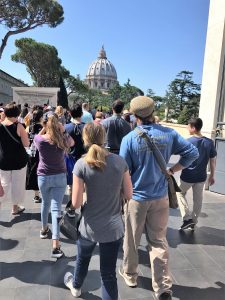
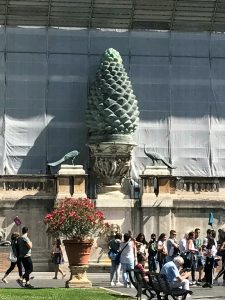
Arnaldo Pomodoro’s “Sphere within a Sphere” sculpture intrigued us…the Death Star? A rotting tomato?
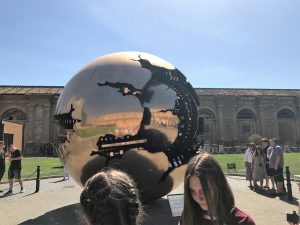
In preparation for viewing a masterpiece of Hellenistic sculpture, “Laocoon and his Sons,” we read a passage in Latin from Book 2 of Vergil’s Aeneid. Engaging all his reader’s senses, Vergil describes how two deadly and mysterious snakes emerge from the sea to entwine and devour Laocoon and his sons, just as the priest was about to dissuade the Trojans from bringing the Greeks’ deadly horse inside the walls of their city.
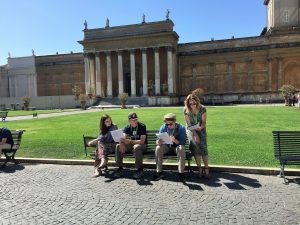
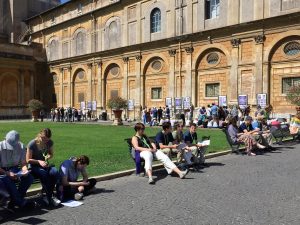
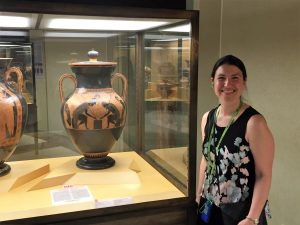
In the Etruscan Rooms of the Museum, Ellen Alvord teaches the group about her favorite Greek vase: Vatican Amphora 344, a black-figure vase by the master painter Exekias depicting Ajax and Achilles playing a board game. We were so lucky that Mount Holyoke College Art Museum’s Curator of Education and Academic Programs joined us on this trip!
A quick lunch in the Vatican Museum cafeteria, and then…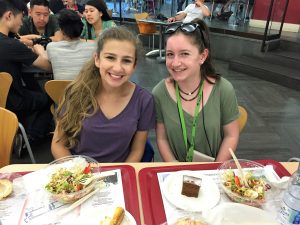 back outside to prepare for our visit to the Sistine Chapel. Mitch leads us in reading through the Latin inscriptions to the paintings which compare the lives of Moses and Jesus on the walls beneath the Sistine Chapel ceiling. We learn that this sort of comparison between Old and New Testament figures is called “Typology,” and that only through Latin can we arrive at genuine Truth and Beauty: all modern attempts to title and describe the scenes are confusing and unclear. Only the Latin lays out the points of comparison with crystal clarity. We knew we loved Latin for a reason!
back outside to prepare for our visit to the Sistine Chapel. Mitch leads us in reading through the Latin inscriptions to the paintings which compare the lives of Moses and Jesus on the walls beneath the Sistine Chapel ceiling. We learn that this sort of comparison between Old and New Testament figures is called “Typology,” and that only through Latin can we arrive at genuine Truth and Beauty: all modern attempts to title and describe the scenes are confusing and unclear. Only the Latin lays out the points of comparison with crystal clarity. We knew we loved Latin for a reason!
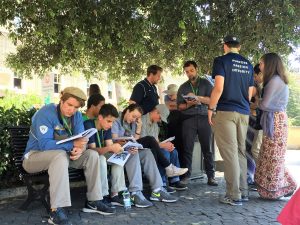
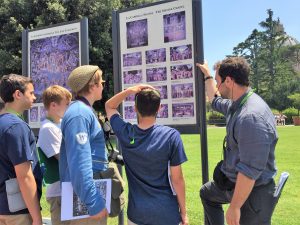
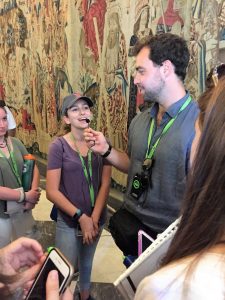
On the way to the Sistine Chapel Nikki takes over the mic to describe some artwork with her keen art-historical analytical skills.
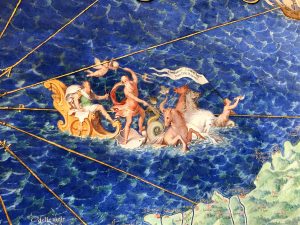 In the Map Room, this depiction of Christopher Columbus catches our eye: he is being borne across the ocean in a water-chariot driven by Neptune himself and drawn by mythical water creatures known as Hippocampi… one of the Sea God’s attendants leads the way, playing a sea shell like a bugle and bearing aloft a flag that reads: Christophorus Columbus Ligur. Novi Orbis Repertor, “Christopher Columbus the Ligurian, Discoverer of the New World.” What a difference a few centuries make!
In the Map Room, this depiction of Christopher Columbus catches our eye: he is being borne across the ocean in a water-chariot driven by Neptune himself and drawn by mythical water creatures known as Hippocampi… one of the Sea God’s attendants leads the way, playing a sea shell like a bugle and bearing aloft a flag that reads: Christophorus Columbus Ligur. Novi Orbis Repertor, “Christopher Columbus the Ligurian, Discoverer of the New World.” What a difference a few centuries make!
When we arrive at the apartments of the Borgia Popes—lavishly painted by Pinturricchio—Sarah Klumpp takes over the mic to teach us about this powerful and corrupt Renaissance family. It was such a treat to have our own modern European historian on board to balance out the classical focus of our trip! (You know that we classicists consider anything after the fall of Rome in A.D. 476 “modern.”)
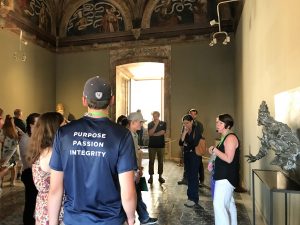
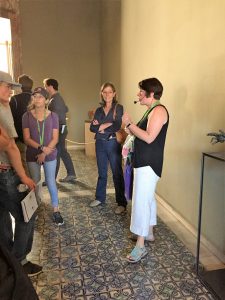
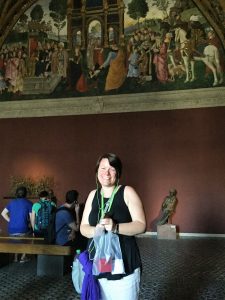
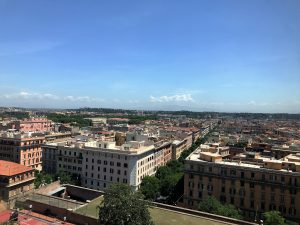
Stunning views of the city from the upper floors of the Museum.
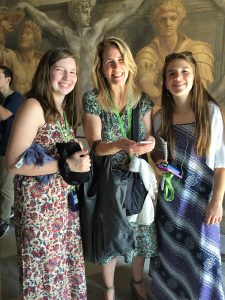
After our long journey through the Vatican we arrive at the Sistine Chapel. (No photography allowed, I’m sorry to say). Our group has been thoroughly prepared by Mitch: we must move straight to the center of the Chapel, and talking is forbidden (since it is a Chapel/place of worship). Guards herd us through the doorway and bark orders for silence. Our respectful, well-mannered Williston students observe all the rules, but keep shooting horrified looks at me as the tourists around us behave as if they were still in the cafeteria! We gaze at the ceiling till our necks are sore, then, when everyone’s done viewing, are shepherded through the secret back door of the Chapel into a courtyard right beside the great Basilica.
We rest for a while, refill our water bottles, and read some Latin: the Gospel of Matthew, 16:16-19 (translated into Latin by…say it discipuli–St. Jerome in the 4th century AD). Jesus to St. Peter: Tu es Petrus, et super hanc petram aedificabo Ecclesiam meam, “You are Peter (Petrus), and above this rock (petram) I will build my church.”
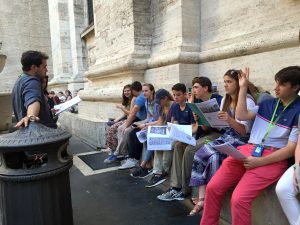
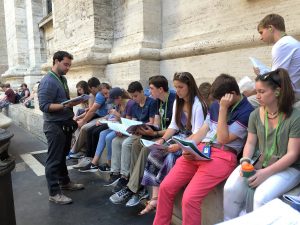
And then, into the biggest indoor space many of us had ever seen…
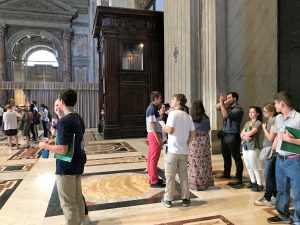
After thoroughly examining the vast interior of St. Peter’s, we slowly began to walk to dinner. We had spent more than nine hours at the Vatican Museum and St. Peter’s Basilica–a Paideia record, according to Mitch!
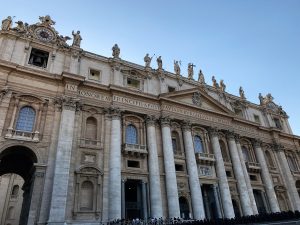
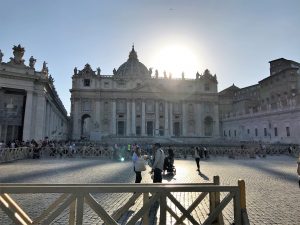
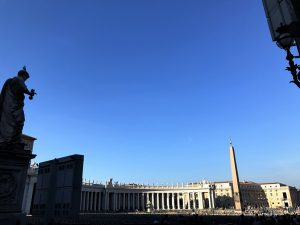
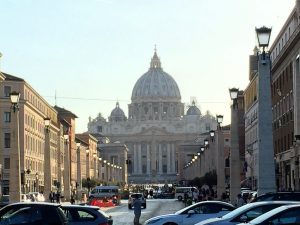
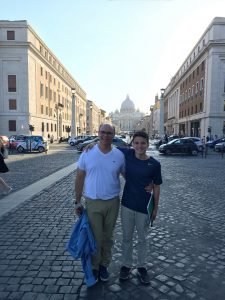
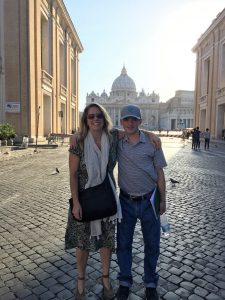
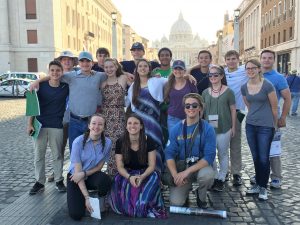
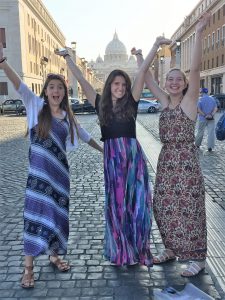
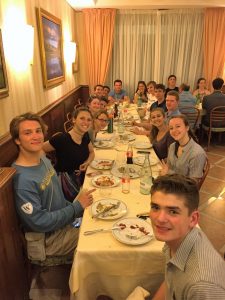


As a Newbie, I am continuously searching online for articles that can be of assistance to me. Thank you